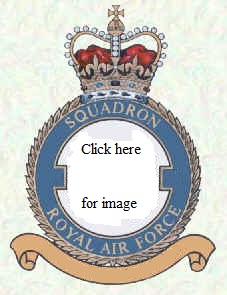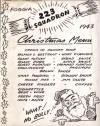Air of Authority - A History of RAF Organisation
No 231 - 235 Squadron Histories
|
No Badge authorised |
Formed at Felixstowe from Nos 329 and 330 Flights on 20 August 1918, it was equipped with Felixstowe F2As and carried out anti-submarine patrols over the North Sea until the end of the war. It disbanded on 7 July 1919. It reformed on 1 July 1940 as an Army Co-operation unit from No 416 Flight at Aldergrove. Initially equipped with Lysanders, these were used for training with the Army as well as patrolling the Border between Ulster and Eire. Tomahawks replaced most of the Lysanders from September 1941 but when Mustangs arrived in July 1943, a flight was still equipped with Lysanders and these probably remained as a detachment when the rest of the squadron moved to England in March. Here it joined 2nd Tactical Air Force as part of No 128 Airfield (later No 128 Wing) beginning operations immediately. These mainly consisted of anti-shipping, meteorological reconnaissance, ground attack and defensive operations. However, the squadron was not destined to participate in the invasion of France in June as it was disbanded on 15 January 1944. It reformed again on 8 September 1944 as a transport unit at Dorval in Canada, when No 45 Group Communications Squadron was redesignated. It operated a number of f types on long range trans-Atlantic transport services to Iceland and the UK, using both flying boats and landplanes. After the war it moved to Bermuda and began services to West Africa, and also began to form a Lancastrian Flight at Full Sutton on 1 December 1945 but before the squadron could convert fully onto this type it disbanded on 15 January 1946, the Lancastrian Flight becoming the Lancastrian Training Unit/No 1699 HCU. |
Squadron Codes used: -
| KR | Allocated Apr 1939 - Sep 1939 |
| VM | Jul 1940 - Apr 1943 |
[Aircraft & Markings | Commanding Officers]
 Formed
on 20 August 1918 from No's 333, 334 and 335 Flights at Felixstowe,
equipped Felixstowe F2 and F3 flying boats and carried out anti-submarine
patrols over the North Sea until the end of the war. It disbanded on 5
January 1919.
Formed
on 20 August 1918 from No's 333, 334 and 335 Flights at Felixstowe,
equipped Felixstowe F2 and F3 flying boats and carried out anti-submarine
patrols over the North Sea until the end of the war. It disbanded on 5
January 1919.
Reformed from 'B;' Flight of No 3 Squadron at Sumburgh on 17 July 1940 as a Hurricane unit, it remained in Scotland on defensive duties until April 1941 when it was earmarked for the Middle East. On 10 May its ground echelon was embarked but the aircrew were carrying out ferrying duties, consequently the ground echelon was disembarked and the squadron moved to Ouston, where it continued its defensive role.
In November the squadron finally departed for the Middle East, but on arriving in South Africa, it was diverted to the Far East following the Japanese invasion of Malaya. Although the ground echelon arrived in Singapore, by the time the air echelon, aboard HMS Indomitable, was within flying off range, there were no airfields left in British hands, so the squadron flew off to Java on 27 January 1942. Both echelons met up again on 2 February at Palembang in Sumatra, but a further withdrawal to Java was required following the Japanese invasion of Sumatra. By mid February 1942, the situation regarding serviceability was so grave, that No 232 was merged with No 242 and its ground crews were evacuated to Ceylon. Here they were re-allocated to other units and No 232 ceased to exist on 25 February.
The squadron reformed at Atcham on 10 April 1942 as a Spitfire unit becoming operational in May. In August it moved to Debden, from where it flew offensive sweeps over France, but in September it moved to Turnhouse and began preparing for overseas deployment once again. Leaving the UK in November, the ground echelon arrived in Gibraltar, being joined by the aircrew and aircraft in December. It moved to North Africa in early December and immediately began undertaking ground attack and fighter operations in support of 1st Army, continuing this task until the end of the North African campaign.
In June 1943 the squadron moved to Malta to support the invasion of Sicily before moving onto that island from where it supported the Allied landings on mainland Italy. In September it moved to airfields in Italy , but in December was re-allocated to the Lebanon for defensive duties. Re-equipped with Spitfire IXs, it moved to Corsica in April 1944 and took part in the Allied landing on the South Coast of France, remaining in France to support the Allied advance north until October 1944, when it returned to Naples and disbanded on 31 October.
The squadron reformed on 15 November 1944 at Stoney Cross as a transport unit equipped with Wellington XVIs until 6 January 1945 when the aircraft were transferred to No 242 Squadron and the ground crews were used to form two other units, No 243 Squadron rear echelon and No 1315 Flight. However, the squadron was not disbanded and it immediately received new aircraft, in the form of Liberators, and crews. These were taken to India in February where it immediately began carrying out transport flights throughout South-East Asia. In July some C-54 Skymasters were received and these were used to fly a Ceylon-Australia service until February 1946 but the service was then resumed in March, the Skymasters having been replaced by Lancastrians. The squadron finally disbanded on 15 August 1946, its routes being taken over by civilian airlines.
Squadron Codes used: -
| XN | Allocated Apr 1939 - Sep 1939 |
| EF | Jul 1940 - Jul 1941, Apr 1942 - Oct 1944 |
[Aircraft & Markings | Commanding Officers]
| In Memoriam |
|
Jack (John) Kenneth Rowberry 22nd Aug, 1922 – 12th July 2015 Leading Aircraftman LAC 1210069 Squadron 232 Armourer / Torpedo Royal Air Force RAF WWII Ground Crew (England, India & Java) 1942 - 1946 |
Squadron Codes used: -
| EY |
Apr 1939 - Sep 1939 |
| ZS | Sep 1939 - Jul 1942 |
| 5T | Mar1944 - Dec 1948 |
 |
 |
| No 233 Sqn Christmas Menu - 1943 (Photos Courtesy - David O'Reilly) |
Decoration produced for Christmas 1943 by No 233 Sqn |
 |
| No 233 Sqn July-August 1945 (Photos Courtesy - Maureen Teulier) |
 |
| No 233 Sqn, August 1943, Gibraltar. Evans
Jones' dad is third from the left "F/O Jones". (Photos Courtesy - Evan Jones) |
[Aircraft & Markings | Personnel, aircraft and locations | Commanding Officers]
No 234 (Madras Presidency) Squadron
 Formed
on 20 August at Tresco in the Scilly Isles from No's 350, 351, 352 and 353
Flights, equipped with Felixstowe F3s which it used to patrol the Western
Approaches. It disbanded in 15 May 1919.
Formed
on 20 August at Tresco in the Scilly Isles from No's 350, 351, 352 and 353
Flights, equipped with Felixstowe F3s which it used to patrol the Western
Approaches. It disbanded in 15 May 1919.
The squadron reformed at Leconfield on 30 October 1939, equipped with Blenheims, Battles and Gauntlets, which it flew on coastal patrols until March 1940. It now began to re-equip with Spitfires, which it took to Church Fenton in May on becoming operational. The following month it moved to St Eval and operated from there and Middle Wallop throughout the Battle of Britain. Throughout 1941 and 1942, the squadron operated from bases in the south and carried out offensive sweeps and defensive duties but in January 1943, it was transferred to the Orkneys.
Six months later the squadron returned to the South of England and was soon operating over France again in preparation for the forthcoming invasion. However, after D-Day, the squadron converted to Mustangs, which it used to provide long range bomber escorts from North Weald and from December 1944, Bentwaters. On 1 May 1945 the squadron was moved to Peterhead to provide a similar service to the Coastal Command strike wings operating along the Norwegian coast.
With the end of the war, the squadron reverted to Spitfires and was retained as part of the post-war RAF. Jets arrived in February 1946, when Meteors replaced the Spitfires, but on 1 September it was disbanded by being renumbered No 266 Squadron. The squadron reformed at Oldenburg on 1 August 1952 in the ground attack role, equipped with Vampires, but in November 1953, it returned to the day fighter role when it began to receive Sabres, conversion being completed in January 1954. The squadron moved to Geilenkirchen in June 1954, where Hunters replaced the Sabres in May 1956, but following the Sandy's White Paper, it was disbanded on 15 July 1957.
The squadron number was allocated to one of the squadron of No 229 Operational Conversion Unit on 22 Oct 1958, operating Hunter F Mk 6 and FGA Mk 9 aircraft to give Hunter pilots their operational training. On 2 September 1974, No 229 OCU was redesignated as the Tactical Weapons Unit and No 234 (Reserve) Squadron remained one of its component. When a second TWU was formed the original was renamed No 1 TWU and again No 234 remained a component. However, No 1 TWU was disbanded on 31 August 1992, along with its component squadrons, including No 234, but the following day the number was allocated to a squadron of No 4 Flying Training School at Valley, which had taken over the duties of the TWUs. The squadron continued as part of no 4 FTS until 1 April 1994, when it was disbanded by being renumbered No 208 (Reserve) Squadron.
Squadron Codes used: -
| AZ | Allocated Apr 1939 - Sep 1939 |
| AZ | May 1940 - Aug 1945 |
| FX | Aug 1945 - Sep 1946 |
| W | Aug 1952 - Jan 1954 |
[Aircraft & Markings | Commanding Officers]
.
Squadron Codes used: -
| SU | Allocated Apr 1939 - Sep 1939 |
| LA |
Oct 1939 - Sep 1942, Jun 1944 - Jul 1945 |
[Aircraft & Markings | Commanding Officers]
235 Squadron Registrar, 71 Wantage Road, Reading, Berkshire, RG30 2SN
Tel: 01189 57 15 32 (eve) andy.bird235ATntlworld.com (change AT to @)
Squadron badge image on this page is courtesy of Steve Clements
© Crown Copyright is reproduced with the permission of the Directorate of Intellectual Property Rights
This page was last updated on 17/03/25©
![]() Organisational Index
Organisational Index ![]()